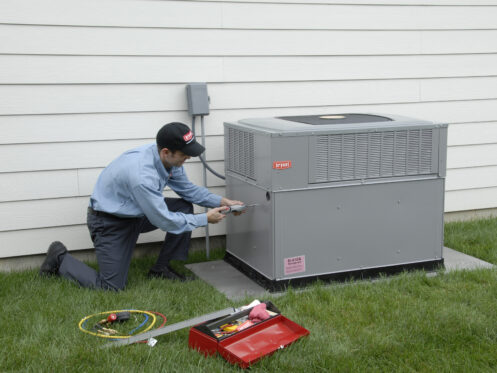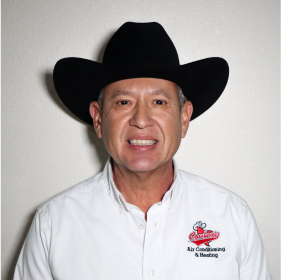Troubleshooting the HVAC system in your San Antonio, TX home helps restore ideal operating conditions. Successful HVAC troubleshooting can be as simple as replacing a dirty HVAC air filter, opening up closed air vents, or correcting faulty thermostat settings. However, when putting things aright involves opening equipment housing and tampering with wired or moving parts, it’s always best to hire professionals. The following are seven solid reasons to avoid do-it-yourself (DIY) HVAC repairs and call a licensed company instead.
1. HVAC Manufacturer Warranties Require It
All new heating and cooling equipment comes with a manufacturer’s warranty. These warranties cover essential replacements and repairs for problems resulting from faulty assembly, defective components, or substandard product designs. As mutually binding agreements, warranties contain stipulations for both parties.
Just as HVAC manufacturers agree to pay for problems that they’re responsible for, homeowners agree to properly maintain covered equipment and take other measures to avoid unnecessary damage. In addition to performing regular air filter changes and scheduling annual furnace, heat pump, or AC maintenance, consumers are also required to hire licensed HVAC companies for all repairs. Performing your own HVAC repairs or hiring an unqualified handyman can result in the automatic voidance of these agreements. Even when it does not, it can still lead to frustrating delays or denials when submitting warranty claims.
Your HVAC Equipment Manufacturer Warranties Might Last Longer Than You Think
Many heaters, heat pumps, and ACs come with limited parts warranties that last five to 10 years. However, furnaces also have heat exchanger warranties that can last up to two decades, and heat pumps and air conditioners have compressor warranties that often span 10 to 15 years. Thus, even with older heating and cooling equipment, you still have good reason to maintain warranty compliance.
DIY Repair Projects Can Compromise Other Protections
DIY HVAC repairs can also land you in hot water with other warranty issuers or your home insurance company. If replacing a faulty AC or heat pump capacitor on your own goes wrong, you’ll have to pay for the resulting electrical system and general building damage out of pocket. With a thorough review of all coverage documents, you’ll likely find that both your home insurance policy and your home service agreement have clear restrictions on DIY appliance repairs. As with HVAC manufacturer warranties, DIY HVAC repairs can result in the immediate termination of important home coverage or unpleasant outcomes when submitting claims.
2. Performing DIY HVAC Repairs Is Unsafe
Furnaces, air conditioners, and heat pumps are hardwired directly into homes. This makes opening fan motor housing and tampering with wired parts a major electrocution hazard. Mistakes made when adjusting or replacing electrical wiring, electrical contacts, faulty circuits, or wired parts can burn your blower motor out or set the stage for an electrical fire.
Refrigerant Handling
Only licensed HVAC companies are qualified and legally allowed to handle residential AC refrigerants. Whether your air conditioner uses Freon, Puron, or Opteon refrigerant, you cannot fix a leak, perform recharge service, or safely and effectively clean up spilled coolant on your own. If you ever attempt to do so, you’ll also find that you cannot lawfully obtain replacement refrigerant for recharge service without an HVAC contractor’s license.
Combustible Fuels and Venting Systems
Gas-fired heating systems require permits. Homeowners cannot purchase these systems on their own or install them. You should never tamper with your furnace’s gas line or its venting system. Any problems affecting these components should instead be reported to your HVAC company or your utility service provider.
Not only are you at risk of sustaining serious and potentially fatal injuries when attempting gas line or venting system repairs, but you also run the risk of causing damage to neighboring properties and harming the people who live on them. Moreover, poorly performed furnace repairs can additionally set the stage for dangerous carbon monoxide (CO) leaks. This odorless, colorless gas is frequently referred to as a “silent killer.” Having functional CO alarms installed does not effectively offset the risks of CO exposure and CO poisoning resulting from DIY heating system repairs.
3. Protect Your Indoor Air Quality
Scheduling professional HVAC system repairs is one of the best ways to protect your indoor air quality. Seasoned HVAC technicians can:
- Clear out tough and difficult-to-reach debris
- Optimize airflow
- Proactively prevent natural gas and exhaust leaks
- Identify the need for integrated HVAC accessories
- Check for balanced indoor humidity
People who regularly skip professional HVAC maintenance and repairs to perform essential tasks on their own often deal with unpleasant heater and AC odors and uncomfortable IAQ-related symptoms like frequent headaches, irritated eyes, coughing, sneezing, and nasal congestion.
4. Maintain Modest, Manageable Home Energy Bills
Correctly diagnosing and fixing HVAC problems is an important part of maintaining affordable heating and cooling costs. Our technicians give each heat pump, furnace, and air conditioner the model-specific service it deserves. Our training and experience allow us to diagnose problems accurately the first time so that we aren’t making unnecessary parts replacements or creating problems where none existed before.
Even if you do diagnose a problem correctly and successfully resolve it, there’s always the chance that a connected or underlying issue is overlooked. Partial fixes can be just as detrimental to the health of building occupants and the performance of heating and cooling equipment as no repairs at all.
5. Extend the Life Span of Your HVAC Equipment
Giving your heating and cooling equipment professional care will make it last longer. Even simply over-tightening bearings or setting the wrong fan speeds can accelerate normal wear and cause your heater or AC to break down before its time. When everything is cleaned, calibrated, lubricated, and primed for optimum performance, HVAC systems experience far less stress and develop far fewer problems going forward.
6. Pay Less for HVAC Repairs Over Time
People often perform their own HVAC repairs in an effort to save money. However, when DIY projects go awry, homeowners can wind up spending hundreds or even thousands of dollars more than they would if outsourcing instead. For instance, if you fail to catch a clogged and dirty AC condensate drain line during a DIY repair, your air conditioner could develop a drain pan leak that damages the nearby flooring, baseboards, and sub-floors. Unchecked drain line problems can also lead to elevated indoor moisture and lingering issues with mildew and mold, among other things. From purchasing the wrong parts to incorrectly installing them, there are lots of ways to waste cash. Simply catching and correcting one issue while allowing another to spiral out of control could lead to premature equipment failure and the need for immediate heater or AC replacement.
7. Enjoy Rapid and Lasting Results
Nothing is more frustrating than attempting to perform a DIY repair only to find that your replacement parts have the wrong specifications. Although there are many online tutorials for DIY HVAC repairs, these resources aren’t guaranteed to be model-specific or even accurate. DIY repairs can leave residents without functional heating and cooling systems when they need them the most. It can also result in new troubles that affect your home comfort just days or weeks after your work is done.
Since 1985, we’ve been proudly serving San Antonio, TX and the surrounding cities. We offer exceptional heating and air conditioning services. We also provide top-notch indoor air quality improvements, smart thermostats, and HVAC ductwork. To find out about our preventative maintenance plans or schedule HVAC repairs, contact Cowboys Air Conditioning & Heating now.







